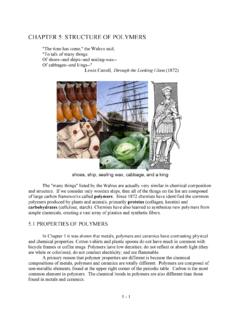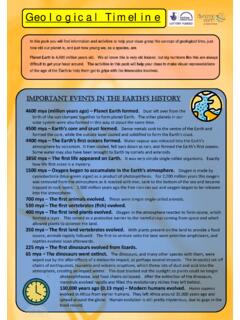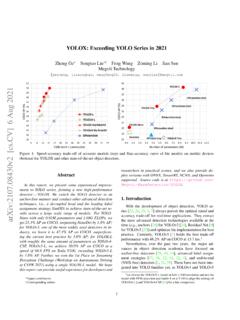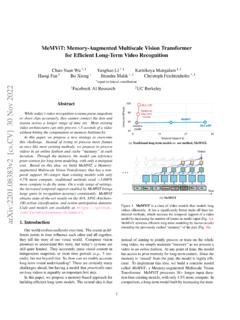Transcription of A collaborative sorting activity for Key stages 2 & 3 ...
1 Animal Classification Dedicated to Eve Levin EMAS4 Success: May 2008 Website Editors: Harvinder Bilkhu & Deborah Barkham Images from Microsoft online and and S. Ghatoray Animal Classification A collaborative sorting activity for Key stages 2 & 3 Teachers notes Contents Animal Cards: 8 Pictures per card (54 +2 blanks) Alphabetical list of pictured animals Group cards: VERTEBRATE/INVERTEBRATE Group cards: FISH, AMPHIBIA, REPTILES, BIRDS, MAMMALS Features.
2 Instruction sheet one per group Vertebrate Key. Classification table and sample paragraph Further paragraphs about each of the animal groups for pupils to complete and Preparation sorting Exercise For each group of students (3-5) copy: Classification table Page 5 One per pupil Pages 6, 7, and 8. Further paragraphs to copy and complete one for each pupil who needs structured support in writing. This pack has been produced to provide a flexible approach to animal classification.
3 By providing a wide range of animal pictures, students can try sorting according to their own criteria before engaging in more formal classification. This gives the opportunity to discuss dilemmas which arise in using criteria such as live in water/live on land or fly/do not fly. Teachers can decide whether to commence with students doing the sorting exercise in groups and then deducing the features for each of the major groups of vertebrates, or to start with a more formal consideration of the features of each animal group, filling out the tick-table and then proceeding to the sorting exercise.
4 The written paragraphs are considered consolidation exercises. The group and individual projects are suggested to provide a variety of activities for both class and homework. This pack has been designed to be used as a free-standing pack or to support activities in the Oxford Science Programme. Pages10-16 (animal pictures) Page 3 (group headings) Page 4 (features) Page 1 (instruction sheet) Page 2 (vertebrate key sheet) Page 9 (alphabetical animal list) Animal Classification 1 Animal Groups sorting exercise What you have to do* Work in groups of 3, 4, or 5.
5 Share the animal cards out. Place the VERTEBRATE/INVERTEBRATE cards at the top of the table. Under the VERTEBRATE heading place the 5 vertebrate groups: FISH, AMPHIBIA, REPTILES, BIRDS, and MAMMALS. Take turns to place a card in a group. Make sure that everyone in your group agrees. If there is any disagreement about a card, put the card on a Dispute pile. Continue placing the cards in the groups until all the known cards are placed. Now place all the FEATURES cards for each group. (Some features are correct for more than one group).
6 Make sure that all the cards in the group fit in with the features. Go through the Dispute pile again, checking each animal against the Features of each group. Use the key on the following page to help you decide which group to put the animal into. * [Note for teachers it is useful to print the various cards in different coloured card Vertebrate/Invertebrate red, Vertebrate group headings yellow, Features beige] Group Project As a group find a way to show information about the features of the five different vertebrate groups to some children who have not yet learned about animal classification.
7 You could choose an example of an animal from each group and find out all about that animal. You can make a poster or a large book. Be prepared to show and talk about your finished work to other groups. Individual Project Choose an animal card and find out all about that animal: where it lives, which country does it come from, what kind of environment it prefers, what it eats, life cycle, how it lives on its own, in pairs, or in packs. Write as much as you can. Animal Classification 2 Use the key below to help you decide which group to put the animal into.
8 Try making your own key by asking different questions. Does it have a backbone at any stage in its life cycle? If Yes Vertebrate If No Invertebrate Vertebrate Key Does it have scales? Yes No Does it have fins and gills. It lays eggs in water? Does it have feathers? Yes No FISH REPTILE Has lungs and lays eggs on land Yes No BIRD Does it lay eggs in water and have two stages in its life cycle? Damp Skin? Yes No AMPHIBIANS MAMMAL Young are born alive and fed on milk. Has steady body temperature Animal Classification 3 Vertebrate Invertebrates Mammals Fish Reptiles Birds Amphibians Animal Classification 4 Features (some features have been repeated because they apply to more than one animal group).
9 Lays eggs in water have babies lay eggs in water hair or fur lay eggs on land or in a nest damp skin lay eggs on land or in a nest gills fins feeds babies with milk lungs lungs steady body temperature lungs lungs steady body temperature scales scales Animal Classification 5 Groups of Animals Classification Animals without backbones - Invertebrates Animals with backbones - Vertebrates Vertebrate Groups FEATURE FISH AMPHIBIANS REPTILES BIRDS MAMMALS backbone fins
10 Scales lay eggs in water lay eggs on land or in a nest have live babies hair/fur damp skin feathers mammary glands feed young with milk gills lungs







